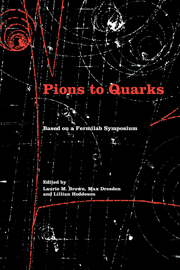Book contents
- Frontmatter
- Contents
- List of contributors
- Foreword by Leon M. Lederman
- Editors' acknowledgments
- Photographs of the symposium
- List of abbreviations
- List of notation
- I Introduction
- 1 Pions to quarks: particle physics in the 1950s
- 2 Particle physics in the early 1950s
- 3 An historian's interest in particle physics
- II Particle discoveries in cosmic rays
- III High-energy nuclear physics
- IV The new laboratory
- V The strange particles
- VI Weak interactions
- VII Weak interactions and parity nonconservation
- VIII The particle physics community
- IX Theories of hadrons
- X Personal overviews
- Name index
- Subject index
1 - Pions to quarks: particle physics in the 1950s
Published online by Cambridge University Press: 07 May 2010
- Frontmatter
- Contents
- List of contributors
- Foreword by Leon M. Lederman
- Editors' acknowledgments
- Photographs of the symposium
- List of abbreviations
- List of notation
- I Introduction
- 1 Pions to quarks: particle physics in the 1950s
- 2 Particle physics in the early 1950s
- 3 An historian's interest in particle physics
- II Particle discoveries in cosmic rays
- III High-energy nuclear physics
- IV The new laboratory
- V The strange particles
- VI Weak interactions
- VII Weak interactions and parity nonconservation
- VIII The particle physics community
- IX Theories of hadrons
- X Personal overviews
- Name index
- Subject index
Summary
Between 1947 and 1963, a period freely referred to here as “the fifties,” elementary particle physics was growing up and undergoing the triumphs and pains of its adolescence. Beginning with the discovery of charged pions in cosmic rays, the period ended with the proposition that the basic constituents of the hadrons are quarks. The period witnessed the vindication of quantum field theory in renormalized quantum electrodynamics (QED), only to see it rejected as a theory of the strong and weak interactions. It saw the concept of symmetry emerge as a fundamental characteristic of basic physics, followed by its downfall in the parity revolution. Researchers discovered particles that were so different from any known previously that they labeled them “strange,” and they found unexpected properties in familiar interactions. The fifties was a time of intellectual turmoil, of shifting attitudes and changing theoretical fashions.
For particle physics, as for science in general, the period was a time of transition, as energy was redirected from the problems of war to the concerns of peace. Profiting from their participation in the radar and atomic bomb projects (we are speaking now mainly of the United States, but that is where the shift began), physicists planned and carried out cooperative scientific research on a scale previously unknown in peacetime and drew on the prestige that derived from their wartime successes to obtain the necessary funding. Elementary particle physics, then called, significantly, “high-energy nuclear physics,” served as a prototype for other large-scale scientific projects, such as the space programs in the United States and the Soviet Union.
- Type
- Chapter
- Information
- Pions to QuarksParticle Physics in the 1950s, pp. 3 - 39Publisher: Cambridge University PressPrint publication year: 1989
- 3
- Cited by



